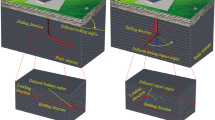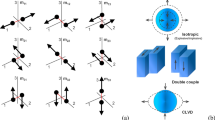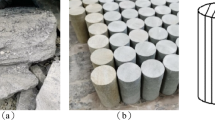Abstract
Under the effect of chemical etching, the macroscopic mechanical properties, mesoscopic structure, mineral content, and porosity of rocks undergo significant changes, which can lead to the geological disasters; thus, an understanding of changes in the microscopic and macroscopic structure of rocks after chemical etching is crucial. In this study, uniaxial mechanical tests and nuclear magnetic resonance (NMR) spectroscopy were carried out on sandstone samples that had been previously subjected to chemical erosion under different pH values. The aim was to study changes in properties and mechanical characteristics, including deformation and strength characteristics, of the rock, and microscopic pore variation characteristics, and to perform preliminary studies of the chemical corrosion mechanism. Results show that different chemical solutions have a significant influence on the uniaxial compressive strength, the axial strain corresponding to the peak axial stress, elastic modulus, etc. With the passage of time, porosity increases gradually with exposure to different chemical solutions, and exposure to chemical solutions results in large changes in the NMR T2 curve and T2 spectrum area. Sandstone exposed to different chemical solutions exhibits different corrosion mechanisms; the root cause is the change of mineral.
Similar content being viewed by others
References
Ivars DM (2006) Water inflow into excavations in fractured rock—a three-dimensional hydro-mechanical numerical study. International Journal of Rock Mechanics and Mining Sciences 43: 705–725. DOI: 10.1016/j.ijrmms.2005.11.009
Zhang HB, Zhang W, Lv L, et al. (2010) Effect of fissure water on mechanical characteristics of rock mass. Mining Science and Technology (China) 20: 846–849. DOI: 10.1016/S1674-5264(09)60293-3
Alonso EE, Zandarin MT, Olivelia S (2013) Joints in unsaturated rocks: thermo-hydro-mechanical formulation and constitutive behaviour. Journal of Rock Mechanics and Geotechnical Engineering 5: 200–213. DOI: 10.1016/j.jrmge.2013.05.004
Dehkhoda S, Hood M (2014) The internal failure of rock samples subjected to pulsed water jet impacts. International Journal of Rock Mechanics and Mining Sciences 66: 91–96. DOI: 10.1016/j.ijrmms.2013.12.021
Abdelghani FB, Aubertin M, Simon R, Therrien R (2015) Numerical simulations of water flow and contaminants transport near mining wastes disposed in a fractured rock mass. International Journal of Mining Science and Technology 25: 37–45. DOI: 10.1016/j.ijmst.2014.11.003
Li GC, Jiang ZH, Lv CX, et al. (2015) Instability mechanism and control technology of soft rock roadway affected by mining and high confined water. International Journal of Mining Science and Technology 25: 573–580. DOI: 10.1016/j.ijmst.2015.05.009
Alonso J, Navarro V, Calvo B, et al. (2012) Hydro-mechanical analysis of Co2 storage in porous rocks using a critical state model. International Journal of Rock Mechanics and Mining Sciences 54: 19–26. DOI: 10.1016/j.ijrmms.2012.05.016
Felice SL, Montanari D, Battaglia S, et al. (2014) Fracture permeability and water–rock interaction in a shallow volcanic groundwater reservoir and the concern of its interaction with the deep geothermal reservoir of Mt. Amiata, Italy. Journal of Volcanology and Geothermal Research 284: 95–105. DOI: 10.1016/j.jvolgeores.2014.07.017
Kodama J, Goto T, Fujii Y, et al. (2013) The effects of water content, temperature and loading rate on strength and failure process of frozen rocks. International Journal of Rock Mechanics and Mining Sciences 62: 1–13. DOI: 10.1016/j.ijrmms.2013.03.006
Eaton TT, Anderson MP, Bradbury KR (2007) Fracture control of ground water flow and water chemistry in a rock aquitard. Ground Water 45: 601–615. DOI: 10.1111/j.1745-6584.2007. 00335.x
Fantong WY, Kamtchueng BT, Yamaguchi K, et al. (2015) Characteristics of chemical weathering and water–rock interaction in Lake Nyos dam (Cameroon): Implications for vulnerability to failure and re-enforcement. Journal of African Earth Sciences 101: 42–55. DOI: 10.1016/j.jafrearsci.2014.08.011
Iler RK (1979) The chemistry of silica: solubility, polymerization, colloid and surface properties, and biochemistry. Wiley-Interscience Publication, New York. DOI: 10.1002/anie. 198002302
Atkinson BK, Meredith PG (1981) Stress corrosion cracking of quartz: a note on the influence of chemical environment. Tectonophysics 77(1-2): T1–T11. DOI: 10.1016/0040-1951(81)90157-8
Ojala I, Ngwenya BT, Main IG, et al. (2003) Correlation of microseismic and chemical properties of brittle deformation in Locharbriggs sandstone. Journal of Geophysics Research 108 (B5): 2268. DOI: 10.1029/2002JB002277
Moore KR, Wall F, Divaev FK, et al. (2009) Mingling of carbonate and silicate magmas under turbulent flow conditions: Evidence from rock textures and mineral chemistry in sub-volcanic carbonatite dykes, Chagatai, Uzbekistan. Lithos 110: 65–82. DOI: 10.1016/j.lithos.2008.11.013
Hu DW, Zhou H, Hu QZ, et al. (2012) A hydro-mechanicalchemical coupling model for geomaterial with both mechanical and chemical damages considered. Acta Mechanica Solida Sinica 25: 361–376. DOI: 10.1016/S0894-9166(12)60033-0
Feng XT, Ding WX (2007) Experimental study of limestone micro-fracturing under a coupled stress, fluid flow and changing chemical environment. International Journal of Rock Mechanics and Mining Sciences 44: 437–448. DOI: 10.1016/j.ijrmms.2006.07.012
Grgic D, Giraud A (2014) The influence of different fluids on the static fatigue of a porous rock: Poro-mechanical coupling versus chemical effects. Mechanics of Materials 71: 34–51. DOI: 10.1016/j.mechmat.2013.06.011
Chai ZY, Kang TH, Feng GR (2014) Effect of aqueous solution chemistry on the swelling of clayey rock. Applied Clay Science 93-94: 12–16. DOI: 10.1016/j.clay.2014.02.027
Feng XT, Ding WX, Zhang DX (2009) Multi-crack interaction in limestone subject to stress and flow of chemical solutions. International Journal of Rock Mechanics and Mining Sciences 46: 159–171. DOI: 10.1016/j.ijrmms.2008.08.001
Xu RN, Luo S, Jiang PX (2011) Pore scale numerical simulation of supercritical CO2 injecting into porous media containing water. Energy Procedia 4: 4418–4424. DOI: 10.1016/j.egypro.2011.02.395
Gao H, Li HZ (2015) Determination of movable fluid percentage and movable fluid porosity in ultra-low permeability sandstone using nuclear magnetic resonance (NMR) technique. Journal of Petroleum Science and Engineering 133: 258–267. DOI: 10.1016/j.petrol.2015.06.017
Zargari S, Canter K.L, Prasad M (2015) Porosity evolution in oilprone source rocks. Fuel 153: 110–117. DOI: 10.1016/j.fuel.2015.02.072
Schoenfelder W, Gläser HR, Mitreiter I, et al. (2008) Twodimensional NMR relaxometry study of pore space characteristics of carbonate rocks from a Permian aquifer. Journal of Applied Geophysics 65: 21–29. DOI: 10.1016/j.jappgeo.2008.03.005
She AM, Yao W (2010) Probing the hydration of composite cement pastes containing fly ash and silica fume by proton NMR spin-lattice relaxation. Science China Technological Sciences 53: 1471–1476. DOI: 10.1007/s11431-010-3134-1
Luo S, Xu RN, Huang XW (2011) Visualization experimental investigations of supercritical CO2 inject into porous media with the fissure defect. Energy Procedia 4: 4411–4417. DOI: 10.1016/j.egypro.2011.02.394
Webber JB, Corbett P, Semple KT, et al. (2013) An NMR study of porous rock and biochar containing organic material. Microporous and Mesoporous Materials 178: 94–98. DOI: 10.1016/j.micromeso.2013.04.004
Liu HB, d’Eurydice MN, Obruchkov S, et al. (2014) Determining pore length scales and pore surface relaxivity of rock cores by internal magnetic fields modulation at 2 MHz NMR. Journal of Magnetic Resonance 246: 110–118. DOI: 10.1016/j.jmr.2014. 07.005
Yao YB, Liu DM, Xie SB (2014) Quantitative characterization of methane adsorption on coal using a low-field NMR relaxation method. International Journal of Coal Geology 131: 32–40. DOI: 10.1016/j.coal.2014.06.001
Wang XX, Shen XD, Wang HL, et al. (2015) Nuclear magnetic resonance analysis of concrete-lined channel freeze-thaw damage. Journal of the Ceramic Society of Japan 123: 1–9. DOI: 10.2109/jcersj2.123.43
Xiao LZ, Liao GZ, Deng F, et al. (2015) Development of an NMR system for down-hole porous rocks. Microporous and Mesoporous Materials 205: 16–20. DOI: 10.1016/j.micromeso. 2014.09.024
Martin CD (1993) The strength of massive Lac du Bonnet granite around underground openings. Ph. D. Thesis, University of Manitoba, Manitoba, Canada.
Eberhardt E, Stimpson B, Stead D (1999) Effects of grain size on the initiation and propagation thresholds of stress-induced brittle fractures. Rock Mechanics & Rock Engineering 32(2):81–99. DOI: 10.1007/s006030050026
Everitt RA, Lajtai EZ (2004) The influence of rock fabric on excavation damage in the Lac du Bonnett granite. International Journal of Rock Mechanics and Mining Sciences 41(8): 1277–1303. DOI: 10.1016/j.ijrmms.2004.09.013
Author information
Authors and Affiliations
Corresponding author
Additional information
http://orcid.org/0000-0001-5884-5952
http://orcid.org/0000-0003-0088-7652
http://orcid.org/0000-0002-2945-5442
http://orcid.org/0000-0002-7614-3484
Rights and permissions
About this article
Cite this article
Cai, Yy., Yu, J., Fu, Gf. et al. Experimental investigation on the relevance of mechanical properties and porosity of sandstone after hydrochemical erosion. J. Mt. Sci. 13, 2053–2068 (2016). https://doi.org/10.1007/s11629-016-4007-2
Received:
Accepted:
Published:
Issue Date:
DOI: https://doi.org/10.1007/s11629-016-4007-2




